Three Unique Concepts For More Effective Apple Search Ads Campaign Management
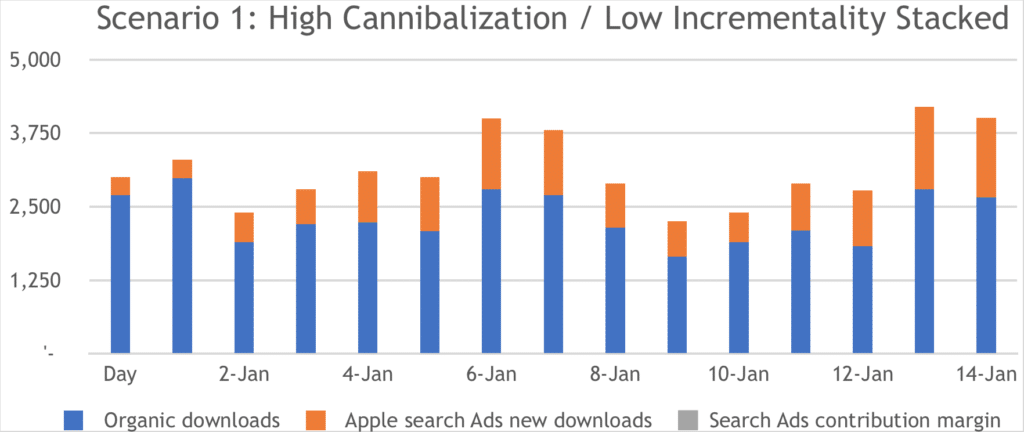
For UA managers unfamiliar with Apple Search Ads, the concepts of single keyword ad groups and how to leverage the CPA goal are some of the most fruitful to grasp for effective Search Ads campaign management. For marketing directors or individuals whose remits also cover ASO, the concept of incrementality is another that is even more vital than the first two for driving effective results for the marketing organization all-up, yet for the time is one not commonly discussed in the industry.
Dive deeper into these three concepts with today’s article, based on the Search Ads 301 presentation I gave at App Growth Summit Los Angeles on February 7th, 2019.
SKAGs (Single keyword ad groups)
SKAGs, which is an abbreviation for Single Keyword Ad Groups, is a carry-over from web PPC management in AdWords or Bing Ads, where the practice is still common today.
This concept refers to the distribution of keywords into ad groups of only one keyword each, so that the campaign manager is afforded a higher degree of control over bidding and ad relevance, with the added bonus of making reporting easier at a glance.
While the act of splitting keywords by ad groups does require more effort to manage and can convolute campaign views and exports, this is nonetheless one of the most useful techniques for scaling Apple Search Ads campaigns while maintaining efficient performance, due to these two main benefits:
- SKAGs enable CPA goal control (and other targeting settings) at the ad group level
- The powerful CPA goal feature is only accessible at the ad group level, hence the need to split keywords into ad groups to effectively control the CPA goal at the keyword level.
- Breaking keywords into SKAGs also enables campaign managers to control the plural vs singular versions of keywords, which in cases can have significantly different performance levels.
- This also enables control over other targeting dimensions such as age or gender, yet this is often not advisable for Search Ads campaigns (except to remove the targeting of users with limited ad tracking enabled) due to reductions in scale.
- SKAGs unlock creative set testing at the ad group level
- This enables campaign managers to create more relevant combinations of ads with their keywords, which can improve margins and scale (keep in mind that TTR is one of the main components of ad rank)
- SKAGs enable campaign managers to also assess the performance of different creative sets with individual keywords.
Take a look around and you will find plenty of support from other Search Ads campaign managers that SKAGs is an excellent technique to put into place in your strategy. Give it a try with a couple of your keywords and see whether you can extract greater efficiency!
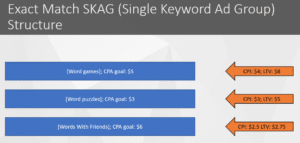
CPA goal tricks
Apple’s CPA goal, in my opinion, is one of the most under-rated features of Apple Search Ads. While the exact details of how it operates are not public information, in short – the CPA goal is a very picky feature and works to predict which auctions your ads have the best conversion rate and ability to drive the right CPT, so that your CPA will back out at the right level. CPA goals are like smart bombs, choosing and guiding themselves to the right targets, rather than the dumb bomb that is the max CPT bid, indiscriminately falling from the bay doors with zero extra guidance (save for being shut down by budget, relevance, or auction performance restrictions).
The following chart illustrates how the CPA goal makes decisions on whether or not to enter an auction depending on the likelihood that your CPA goal will be achieved, as well as what can happen when running campaigns that have limited budget without a CPA goal; if you have a limited budget, it’s even more important to utilize the CPA goal to make your dollar go farther.

Here are several additional tips for your consideration on the subject of the CPA goal:
- Use the CPA goal by default and explore the use of max CPT bid only on a case-by-case basis. At Incipia we use the CPA goal far more often than not and find immense comfort in the CPA goal’s ability to consistently drive a certain cost per download, with some time.
- While the CPA goal will, for the vast majority of cases, drive a CPA within the goal set, the CPA goal does not act as a maximum price, as is in Search Ads Basic. This is especially true when setting very aggressive CPA goals. Mitigate the issue of overshooting CPA by using a Search Ads automation tool to pause keywords that pass a certain CPA.
- Keep in mind that Apple’s new downloads are not the same thing as a first open tracked by a mobile measurement partner, and Apple, like all other channels can claim credit in its UI for contested installs or downloads that are never opened.
- Mobile growth consultant Thomas Petit indicates that CPA goals are not necessary and can act to unnecessarily minimize volume for exact match keywords with stable performance, yet calls this technique out as an interesting one to explore for broader targets like search or broad match.
- Use a high max CPT bid in tandem with a CPA goal (i.e. bid higher than your CPA goal) in order to give your CPA goal the ability to compete with a higher bid in auctions where the competition’s ad rank scores are lower, and you can win a cheaper CPT price, leading to your CPA goal being achieved.
- If a previously top-performing keyword begins to get out of control, try dropping your CPA goal by 50-90%, which will sometimes rehabilitate performance by re-focusing your ads on only impressions they are likely to win, and thus rehabilitating your auction ad rank score, leading to an immediate improvement in CPA and an improvement in scale over the long-term.
Cannibalization/Incrementality
The concept of cannibalization is as old as the first search advertisement itself. The concept refers to the fact that, because Search Ads are placed at the top of the organic results, sometimes both the ad and organic result both show up on the user’s screen, leading to the question of whether or not, if the user clicks the ad, that user would have clicked on the organic result in the case the ad were not shown.
If the user were to click on the organic result anyway, then that ad is said to have cannibalized the organic result, causing the advertiser to pay for activity they would have earned for free. But if the user would not have clicked on the branded result and the only way to capture that user’s tap would be with an ad, then the ad is said to be incremental and the money well spent. Cannibalization and incrementality can be referred to interchangeably, as reciprocal terms.
The problem is that it is impossible to fully predict whether an ad will cause cannibalization or incrementality until the user has made their decision.
While the topic of cannibalization is most often discussed in terms of brand results, the concept is important for non-branded search ad strategy as well, where cannibalization is less, but can still occur if the app’s organic result is first.
Also – while today’s post is specialized to Apple Search Ads, cannibalization can also occur for UAC ads (for both search and explore traffic).
To illustrate the mechanics of cannibalization, consider the following diagrams depicting two scenarios: one involving a Search Ads campaign that causes progressively higher cannibalization of organic searches, and another that causes progressively lower cannibalization of organic searches.
Organic downloads are calculated by subtracting Search Ads downloads from app search source type app units. Keep in mind that the data point from Apple Search Ads that you should be subtracting from app store search app units in iTunes Connect is new downloads, not conversions; conversions includes re-downloads, which are not counted as app units (app units are first-time downloads).
Search Ads contribution margin is calculated by dividing the number of daily Search Ads new conversions by the total app store search source type app units.
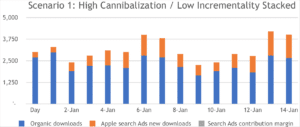
In the graph above, you can see the segmented stacked chart of app store search app units, along with the contribution margin of Search Ads. While total downloads are increasing, the number of organic downloads is not, indicating a high cannibalization and growth only fueled by ad spend.
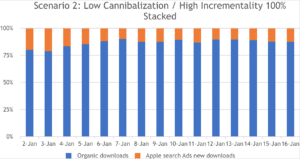
This 100% stacked chart shows the change in Search Ads contribution margin with more clarity.
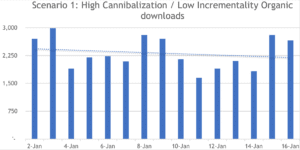
Moreover, this graph shows that not only is the growth fueled by ad spend, but that the cannibalization is actually increasing, and if the organic keyword ranks have not significantly changed, this indicates that money is being spent on users who would have converted via organic (i.e. download credit is being re-attributed from organic to Search Ads).
Now let’s take a look at the opposite scenario, one of high incrementality.


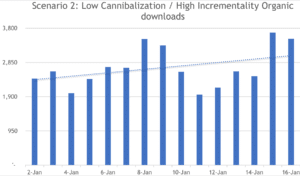
In these graphs, you can see that there is also growth in downloads, yet this time the growth is largely fueled by an increase in organic app units.
If downloads grow and the Search Ads contribution margin stays flat or decreases, then the Search Ads can be assumed to be more incremental.
You can mitigate cannibalization and drive more incrementality by measuring it over time, and by focusing Search Ads budget on keywords that have a lower change of being cannibalized by Search Ads, because they are ranked higher.
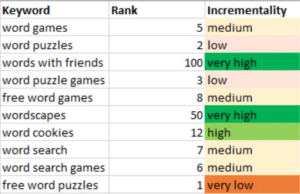
Thanks for reading. You can find the full set of slides here. See you at a future App Growth Summit event!









